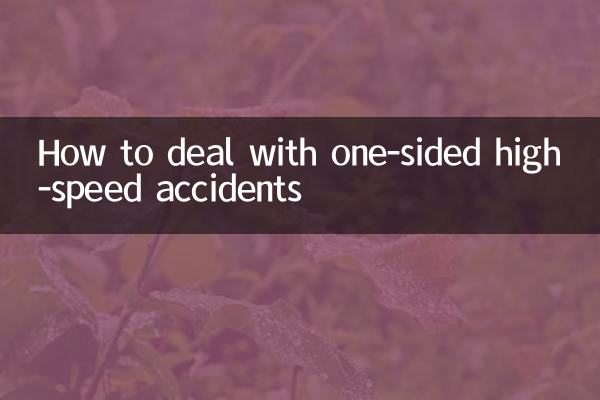How to deal with one-sided high-speed accidents
A one-way accident on the highway is an unexpected situation that many drivers may encounter. Handling accidents correctly not only ensures personal safety, but also avoids subsequent disputes and legal issues. This article will combine the hot topics and hot content on the Internet in the past 10 days to provide you with a detailed introduction to the handling process, precautions and related data of high-speed unilateral accidents.
1. Definition of high-speed unilateral accident

Unilateral accidents refer to independent accidents caused by factors such as driver error, vehicle failure or road environment while the vehicle is driving, and do not involve other vehicles or pedestrians. Common unilateral accidents include hitting guardrails, overturning, and losing control of tires due to tire blowouts.
2. Handling procedures for high-speed unilateral accidents
The following are standard handling steps for high-speed one-sided accidents:
| steps | Specific operations |
|---|---|
| 1. Ensure safety | Immediately turn on the double flashing lights, move the vehicle to the emergency lane (if movable), and place a warning triangle 150 meters behind the vehicle. |
| 2. Check for casualties | Check whether the people in the car are injured. If anyone is injured, call 120 for emergency treatment immediately. |
| 3. Alarm | Dial 122 or the highway police number (such as 12122) to report the accident location, vehicle information and casualties. |
| 4. Take photos to collect evidence | Take photos of the accident scene, damaged parts of the vehicle and surrounding environment to retain evidence. |
| 5. Contact your insurance company | Call the insurance company, submit accident information and apply for a claim. |
| 6. Waiting for processing | After arriving at the scene, the traffic police cooperated with the investigation and handled follow-up matters in accordance with the instructions. |
3. Common causes of high-speed unilateral accidents
According to recent statistics from the transportation department, the main causes of one-way accidents on highways are as follows:
| Reason | Proportion |
|---|---|
| Drowsy driving | 32% |
| speeding | 25% |
| Vehicle failure (e.g. flat tire) | 18% |
| Bad weather (rain, snow, fog) | 15% |
| Operational errors (rushing directions, etc.) | 10% |
4. Precautions for high-speed unilateral accidents
1.Never negotiate privately on your own: In high-speed accidents, the traffic police must issue a liability determination letter, otherwise the insurance company may refuse to pay compensation.
2.Avoid secondary accidents: People should evacuate outside the guardrail and do not stay in the driveway.
3.Keep complete evidence: Including driving recorder video, scene photos and documents issued by the traffic police.
4.Repair vehicles promptly: After the accident, the vehicle needs to be fully inspected to avoid hidden dangers.
5. Key points of insurance claims
Unilateral accidents can usually be compensated through car damage insurance, but the following should be noted:
| Project | Description |
|---|---|
| Time limit for reporting a crime | The case needs to be reported within 48 hours. Failure to do so may affect claim settlement. |
| Deductible | Some insurance companies set an absolute deductible rate (such as 10%). |
| rescue costs | Reasonable expenses such as towing fees may be included in the claim. |
6. Hot topics discussed by netizens
Recently, popular discussions on high-speed unilateral accidents on social platforms include:
1. “How is the liability divided when a Tesla hits a guardrail in autopilot mode?”
2. "Should you brake suddenly or lightly after a tire blowout? Experts explain the correct operation."
3. "High-speed guardrail compensation is sky-high? Do car owners have to bear the cost?"
Summary
Although there is no third-party liability for unilateral high-speed accidents, improper handling may still lead to serious consequences. Mastering the correct handling procedures, understanding insurance rules and improving safety awareness are compulsory courses for every car owner. It is recommended to check the condition of the vehicle regularly and avoid driving while fatigued to reduce the risk of accidents.

check the details

check the details